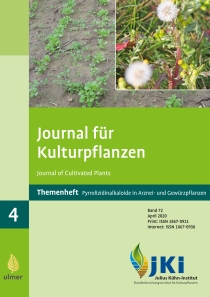Pyrrolizidine alkaloids in Senecio vulgaris L. depending on development stage and season
DOI:
https://doi.org/10.5073/JfK.2020.04.07Keywords:
pyrrolizidine alkaloids, common groundsel, ontogeny, seasons, toxic plant compoundsAbstract
The common groundsel (Senecio vulgaris L.) is a harmful weed because of its toxic compounds (pyrrolizidine alkaloids, PAs) and its enormous distribution potential in agricultural and horticultural crops (Robinson et al., 2003; BfR, 2007; Wiedenfeld, 2011; Wiedenfeld und Edgar, 2011). During different seasons and in plot-field experiments we have examined the growth parameters and the amount of different PAs of Senecio vulgaris L. related to ontogenetic differences.
As already shown for other Senecio species, the PA content in Senecio vulgaris (PAs total, tertiary PAs and PA-N-oxides) is influenced by the developmental stage, depending on the season. In general, there is a tendency for the PA concentration to increase until full flowering and subsequently to decrease again for fruit and seed maturity. In each developmental stage the contents of the N-oxides were higher than the corresponding tertiary PAs. The individual compounds are influenced differently in their concentration: while some PAs are always subject to a significant influence by ontogenesis (retrorsine-N-oxide, senecionine), influences for senecivernine-N-oxide could only be detected in one season.








